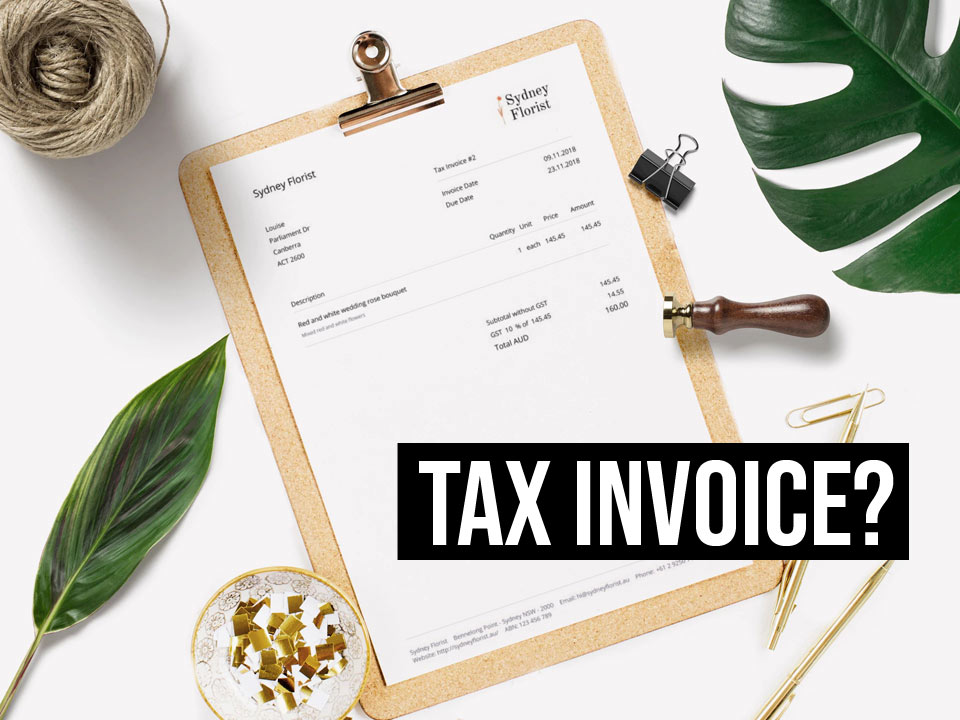It’s easy to get confused about what makes an invoice a tax invoice. After all, they look alike, they include similar information, and they’re both considered legal documents.
To make things a bit clearer, this blog post answers some of the most common questions about invoicing and tax invoices - from how you can identify an Australian tax invoice, to how they can be sent.

How is a tax invoice different from a regular invoice?
Companies send invoices to customers to let them know how much they need to pay. A tax invoice is no different, but it also serves an additional purpose: to help buyers, sellers, and tax authorities understand and process the tax due on specific sales. As such, the main difference between a standard invoice and a tax invoice is that the tax invoices include information about Goods & Services Tax (GST), whereas regular invoices don’t.
Whether you send invoices or tax invoices, you should keep a full, complete record of your sales documents. Both types of invoices are used for annual accounts and financial reports, while tax invoices are also needed to claim tax credits. Its therefore essential that you meet record-keeping guidelines and requirements, whichever type of invoice you send.
Do I need to send a tax invoice?
Whenever you make a sale, you should bill your customer, but whether you do this with standard invoices or tax invoices depends on whether or not you’re registered for GST.
If you are registered for GST, you need to send tax invoices for every taxable sale over $82.50. According to the official guidelines in Australia, you should send a tax invoice within 28 days of receiving a request.
If you aren’t GST-registered, you shouldn’t charge GST and the invoices you send to customers don’t need to include any details about tax. Instead, you can just send a standard invoice.
If you aren’t registered for GST but a customer asks for a tax invoice, you should send an invoice that indicates that no GST is due on the purchase. To do this, you can either write ‘price does not include GST’ or write the GST due as zero.
I have customers abroad, do I send a tax invoice or a regular invoice?
If you sell goods or services to a customer outside of Australia, you (usually) don’t charge GST, even if you’re GST registered. You therefore shouldn’t include GST on invoices you send to customers abroad. Of course, there are some exceptions to this rule, which you can read more about on the ATO’s website.
If you export goods or services to another country, you can choose which currency to use for invoicing. While it might be easier to stick to Australian dollars, many customers appreciate receiving invoices in their local currency. If you do decide to use another currency, you’ll need to be aware of exchange rates, and how you might be affected by exchange gain or loss.

Do tax invoices use different invoice templates?
The template of a tax invoice is essentially the same as a regular invoice template - you can use the same design for both types of invoice, which are both covered by voluntary standards.
If you make a taxable sale of $1,000 or less, you need to send a tax invoice that includes the following seven details, in addition to the information you would normally include on a standard invoice:
- The words ‘tax invoice’ instead of just ‘invoice’
- Your details (name, address, contact details, etc.)
- Your Australian Business Number (ABN) or Australian Company Number (ACN)
- The issue date
- A description of the items sold, including the quantity and the price
- The total amount of GST payable (if any). You can put the total for the whole invoice, or specific GST for specific items.
- The extent to which each sale includes GST. For example, a phrase along the lines of 'total price including GST'.
If you make a sale of more than $1,000, you will also need to include the customer’s ABN.
What about invoices with taxable and non-taxable sales?
In Australia, most goods and services are taxed at a rate of 10%, but some items are exempt from GST - including most basic foods, some medical-related goods and services, and some childcare services.
Although it’s only common in a few specific industries, it is possible to have both taxable and non-taxable items within a single sale. If this happens, you should send an invoice that clearly shows which of the items listed are taxable, as well as the total amount of GST to be paid.
What’s the best way to send a tax invoice?
There’s a few different ways to go about invoicing, and the process is the same whether or not your invoices include tax.
It can be tempting to stick to what you know and create invoices with Word or Excel, but this can get repetitive and increases the chance of mistakes. A more efficient option for creating tax invoices is invoicing software, which has several advantages over Word and Excel.
When it comes to sending invoices, you also have a few different options. Invoices can be delivered online, by email, via post, or even in person. However, you should bear in mind that your invoices need to reach your customers within 28 days - including delivery time. Online invoicing software lets you create invoices in less than a minute, helping you send invoices quickly and easily from any device.
What else should I know?
Looking for more information? If you’re a freelancer, entrepreneur, or sole trader in Australia, check out the Australian section of our blog, where we give useful tips and advice on invoicing, accounting, and running a small business.
